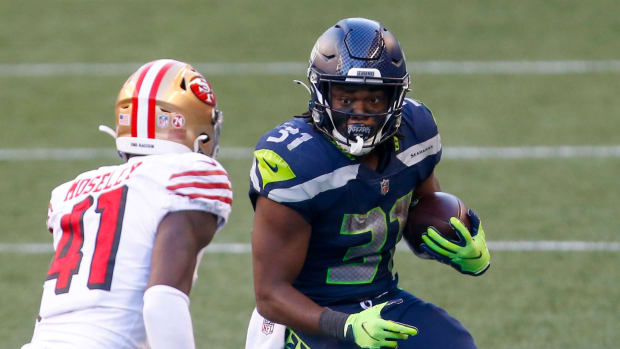Film Breakdown: Understanding Basics of Seahawks 'Bear' Front
Over the past three weeks, the Seahawks have taken a complete 180 degree turn on defense, transitioning from league laughingstock into a suddenly formidable unit.
Only a month ago, Seattle found itself on pace to obliterate Green Bay's record for passing yards given up by nearly 1,000 yards. Through the first half of the season, they had surrendered over 360 net passing yards per game, allowing opposing quarterbacks to carve them up at will.
But since halftime of a Week 10 loss to the Rams, the Seahawks have been firing on all cylinders defensively thanks to an invigorated pass rush and improving secondary play. Over the past 10 quarters, they've allowed 45 combined points, including holding the Eagles to 17 points in a win last Monday night.
While there's no question the addition of defensive end Carlos Dunlap and improving chemistry in the defensive backfield have been catalysts for the rapid turnaround. after being the scapegoat during Seattle's first half struggles, defensive coordinator Ken Norton Jr. also deserves praise for schematic adaptations that have played a role in the much improved play on that side of the ball.
Most notably, the Seahawks have been deploying "bear" fronts featuring three defensive tackles, two edge rushers, and two off-ball linebackers with increasing frequency. When asked about the adjustment, coach Pete Carroll credited Norton for getting the most out of the team's personnel defensively, including safety Jamal Adams and linebacker Jordyn Brooks.
"You have seen us adapt to our personnel and we have -we have enough background that we can do a lot of things," Carroll elaborated. "We have been through so much over the years and I think Kenny [Norton] is exhibiting that to you [through] the use of our talent. And Jamal's part of it, Jordyn [Brooks] coming to us as well is part of it. And absolutely it fits, like we have said to you, about Carlos, his work as a nine technique which puts him outside edge on, to the field in our defense, puts him exactly where he can be really most effective."
How does the "bear" front work? Up front, the Seahawks have a nose tackle in 0-tech alignment head up across from the center. Two other defensive tackles line up in 3-tech or sometimes 4i-alignment either shading the B-gap or the inside shoulder of the opposing tackle. On the outside, two defensive ends/hybrid linebackers are split out wide in 9-alignment and can either rush the quarterback or drop into coverage.
This season, Poona Ford has primarily played the nose tackle role, while Jarran Reed, L.J. Collier, and Rasheem Green have been seeing most of the snaps at the 3-tech spots and Dunlap or Benson Mayowa has been wide at one of the end spots. K.J. Wright, playing the SAM linebacker role, has normally been at the other wide-9 position off edge.
While Adams has still been dropping back into two-deep safety looks, playing "robber" assignments, and handling man-to-man obligations in coverage, his greatest strength lies in his ability to be disruptive in the box. Bear fronts allow Seattle to shift him closer to the line of scrimmage, thus creating flexibility to blitz him in a number of different ways and get downhill as a run defender.
When he hasn't been occupying the WILL linebacker role, Brooks has been gradually been earning more snaps and improving by week. Though he's made his share of mistakes, the first-round pick out of Texas Tech has flashed his 4.5 40-yard dash speed chasing down ball carriers and covering tight ends and running backs in coverage, making him an ideal fit for the position in those 5-2 looks.
With Brooks and occasionally Adams joining Bobby Wagner as the other off-ball linebacker, Wright has found a home at the SAM linebacker spot. Playing off the edge more than he has at any point in his career, he's made several big run stops as of late, including corralling Cardinals quarterback Kyler Murray for a tackle for loss on a read option run. He's also been rushing the passer with greater frequency, producing 2.0 sacks in the last four games.
As Carroll noted, however, Dunlap's arrival is what has really brought everything together. At 6-foot-6, 285 pounds, the veteran offers the size, length, and athleticism Seattle covets at the LEO defensive end spot. Already with 4.0 sacks in four games, he's been equally impressive stopping opposing ground games, helping set the edge for one of the NFL's best run defenses.
"I'm thrilled that you can see it coming together, it's taken us a few weeks. We weren't quite there, we wanted to work with Bruce [Irvin] and that edge position and when we lost him we took a couple steps back to get kind of re-oriented, but I think the defense is really moving now and I'm really excited about where we're going."
With five games left to play, the Seahawks will certainly face opponents in the future where it's not conducive to use "bear" fronts as often as they did on Monday night. But given the vastly different strengths for this unit compared to the "Legion of Boom" defenses of the past, expect Carroll and Norton to continue scheming out of those looks to maximize on their personnel throughout the rest of the season.




